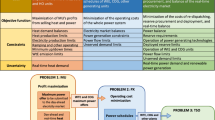Abstract
It is far more important how the cogeneration units are operated than whether they represent the latest technology progress or not. Therefore, for the management of cogeneration units it is a key issue to find optimal operating conditions bringing in the largest income. This may be achieved by combined marginal and overall performance criteria application. To prove this statement, two cogeneration units operating in the Slovak Republic, marked as A and B, were examined. Both of them use the liberal market environment and participate in provisioning ancillary services. Marginal profit values without and with ancillary services provisioning clearly indicate the most advantageous base load value, which is in both cases in the middle of the load regulation range. As shown, together with the total profit function, they are very suitable indicators of the optimal load location and a flexible tool for the market situation evaluation. Heat delivery capability of B to customers reaches its maximum at the middle of the load regulation range, again reinforcing the optimal part load operation. Being equipped with supplementary firing, the marginal steam production of B was found to be higher than 100 % which confirms that the rules for marginal quantities values are not as strict as those for overall and specific quantities.
Similar content being viewed by others
References
Benelmir, R., & Feidt, M. (1998). Energy cogeneration systems and energy management strategy. Energy Conversion and Management, 39, 1791–1802. DOI: 10.1016/S0196-8904(98)00055-7.
Boonekamp, P. G. M. (2006). Evaluation of methods used to determine realized energy savings. Energy Policy, 34, 3977–3992. DOI: 10.1016/j.enpol.2005.09.020.
Carapellucci, R., & Milazzo, A. (2007) Repowering combined cycle power plants by a modified STIG configuration. Energy Conversion and Management, 48, 1590–1600. DOI: 10.1016/j.enconman.2006.11.024.
Difs, K., & Trygg, L. (2009). Pricing district heating by marginal cost. Energy Policy, 37, 606–616. DOI: 10.1016/j.enpol.2008.10.003.
Facchini, B., Fiaschi, D., & Manfrida, G. (1997). SCGT/CC: An innovative cycle with advanced environmental and peakload shaving features. Energy Conversion and Management, 38, 1647–1653. DOI: 10.1016/S0196-8904(96)00205-1.
Franco, A., & Casarosa, C. (2002). On some perspectives for increasing the efficiency of combined cycle power plants. Applied Thermal Engineering, 22, 1501–1518. DOI: 10.1016/4S1359-4311(02)00053-4.
Jonsson, M., & Yan, J. (2005). Humidified gas turbines-a review of proposed and implemented cycles. Energy, 30, 1013–1078. DOI: 10.1016/j.energy.2004.08.005.
Kristiansen, T. (2007). The Nordic approach to market-based provision of ancillary services. Energy Policy, 35, 3681–3700. DOI: 10.1016/j.enpol.2007.01.004.
Kalitventzeff, B., Maréchal, F., & Closon, H. (2001). Better solutions for process sustainability through better insight in process energy integration. Applied Thermal Engineering, 21, 1349–1368. DOI: 10.1016/S1359-4311(01)00024-2.
Maidment, G. G., & Prosser, G. (2000). The use of CHP and absorption cooling in cold storage. Applied Thermal Engineering, 20, 1059–1073. DOI:10.1016/S1359-4311(99)00055-1.
Maréchal, F., & Kalitventzeff, B. (1997). Identification of the optimal pressure levels in steam networks using integrated combined heat and power method. Chemical Engineering Science, 52, 2977–2989. DOI: 10.1016/S0009-2509(97)00102-4.
Panno, D., Messineo, A., & Dispenza, A. (2007). Cogeneration plant in a pasta factory: Energy saving and environmental benefit. Energy, 32, 746–754. DOI: 10.1016/j.energy.2006.06.004.
Pasha, A., & Jolly, S. (1995). Combined cycle heat recovery steam generators optimum capabilities and selection criteria. Heat Recovery systems and CHP, 15, 147–154. DOI: 10.1016/0890-4332(95)90021-7.
Poullikkas, A. (2005). An overview of current and future sustainable gas turbine technologies. Renewable and Sustainable Energy Reviews, 9, 409–443. DOI: 10.1016/j.rser.2004.05.009.
Raineri, R., RÍos, S., & Schiele, D. (2006). Technical and economic aspects of ancillary services markets in the electric power industry: an international comparison. Energy Policy, 34, 1540–1555. DOI: 10.1016/j.enpol.2004.11.015.
Slovak Regulatory Office for Network Industries (2009). Regulatory Office’s decrees. Retrieved April 30, 2009, from http://www.urso.gov.sk/sk/regulacia/elektroenergetika/cr/e-cr.
Svensson, I.-L., Jönsson, J., Berntsson, T., & Moshfegh, B. (2008). Excess heat from kraft pulp mills: Trade-offs between internal and external use in the case of Sweden-Part 1: Methodology. Energy Policy, 36, 4178–4185. DOI: 10.1016/j.enpol.2008.07.017.
Thorin, E., Brand, H., & Weber, C. (2005). Long-term optimization of cogeneration systems in a competitive market environment. Applied Energy, 81, 152–169. DOI: 10.1016/j.apenergy.2004.04.012.
Variny, M., & Mierka, O. (2009). Improvement of part load efficiency of a combined cycle power plant provisioning ancillary services. Applied Energy, 86, 888–894. DOI: 10.1016/j. apenergy.2008.11.004.
Ziher, D., & Poredos, A. (2006). Economics of a trigeneration systems in a hospital. Applied Thermal Engineering, 26, 680–687. DOI: 10.1016/j.apthermaleng.2005.09.007.
Author information
Authors and Affiliations
Corresponding author
Rights and permissions
About this article
Cite this article
Variny, M., Mierka, O. Implementation of marginal quantities in management of cogeneration units operating in liberal market environment. Chem. Pap. 64, 163–173 (2010). https://doi.org/10.2478/s11696-009-0097-4
Received:
Revised:
Accepted:
Published:
Issue Date:
DOI: https://doi.org/10.2478/s11696-009-0097-4




